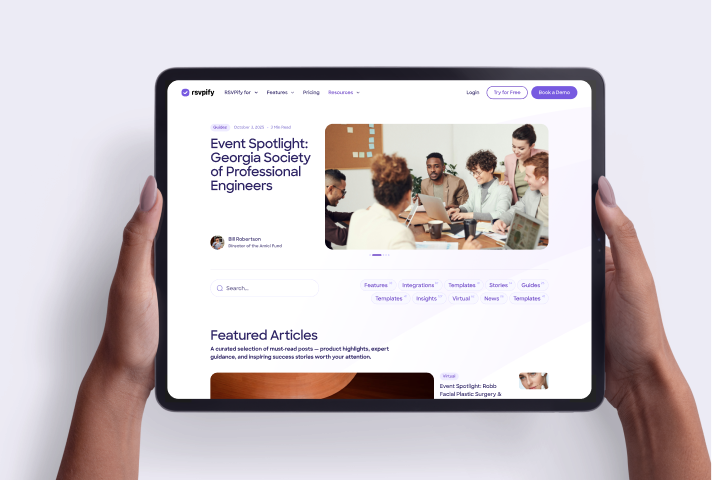So your event is over — what’s next? Time to debrief!
At RSVPify, we call the event debrief an event retrospective (“retro” for short). New to retros or looking to improve your existing debrief format? Let's walk through how to use an event debrief template to measure event engagement and event ROI, identify areas of success and future growth, and improve future event planning.
The purpose of an event debrief is to give your team a chance to come together and reflect on what went well and what can be improved for the next event. By looking across many areas — like financial results, attendance, marketing efforts, and overall logistics — teams collectively celebrate successes and learn from any challenges faced.
Event debriefs offer a place for open and constructive dialogue, and when done well, the event retro is a team-building and event buy-in activity. When your team can reflect together — creating shared memories of success and opportunity, they can also plan for the future together — creating shared expectations for your next event.
For the most inclusive retro, invite anyone who had a direct hand in the planning or execution of the event. If this makes your group quite big, you might consider hosting separate retros for more focused conversations — e.g., one retro for day-of operations (where you include a volunteer lead, check-in lead, technical + IT support, etc.) and another retro for fundraising (where you include your board, event committee, etc.).
The first part of the event retro outlines roles, goals, and ground rules:
In Part 1, you lay the groundwork for the retro conversation; part 2 is where the action happens! It is the heart of the event retro; it happens in three stages; and it is timed.
This is a fun follow-up. Ideas may have been shared during the discussion in part 2 as improvements for the next event. Building on this list, the facilitator opens the floor for a few minutes to surface other ideas for next steps. This list of “next steps” is shared generally in follow-up.
This last part is optional - but usually a good team-building finisher. It‘s the kudos section.
Event planning is hard work - and every event is filled with moments that are important to recognize and celebrate. The kudos selection invites participants to recognize each other.
While some folks may have written kudos in part 2 (filling the remaining time to upvote), everyone in the retro spends a few minutes writing at least one kudogram. The facilitator selects one person to read the kudos aloud and folks can celebrate along the way.
To make the most out of your retro, here's a template for prepping for the event debrief process.
Start by creating your retro team — Assign someone on your team to be:
Align with your team and your organization’s leadership about the purpose of the retro: to capture successes, learnings, and observations about the fundraising event to prep for the next event. Alignment here will create initial buy-in with your leadership to come with an open mind and act on feedback.
Your retro should cover event fundraising, attendance, budget, and more. Be sure you’re prepared for the retro with whatever reports you might need to share with the group.
A retro is different from a round-robin conversation (where everyone waits their turn to contribute). It’s easiest to choose a tool that will let folks participate at the same time.
The best participants are those that come to the meeting ready to participate.
If your conversation is one hour, you likely do not need a break, but if you’re planning for a longer conversation, it will be important to add time for a bio break for participants. One of the great things about breaks is the free flowing conversation that happens, inspired by the retro conversation. If your notetaker can be present for these breaks, that helps capture any nuggets for your team.
What will you commit to doing after the retro? Share notes from the meeting? Share a meeting summary? Make an idea list for the next event? Send a simple thank you to participants? Something else? Envision what your follow-ups will look like and who will do them to reduce the reporting burden.
About the Author
Adam Hausman co-founded RSVPify in 2013 and has been passionate about event tech and ticketing software ever since. Also founder of Greenlight Growth Marketing, he holds degrees from Indiana University (BA English/Psychology 2008) and the University of Illinois-Chicago (M.Ed. Secondary Education 2012). He lives in Maine with his wife, 2 kids, and 2 annoying cats.
Get the latest product updates, event planning tips, and industry insights — straight to your inbox.
You can unsubscribe at any time. Your email will only be used to send RSVPify updates and will never be shared.
